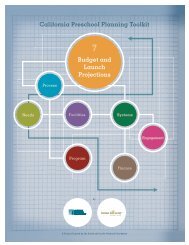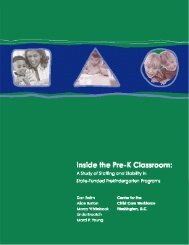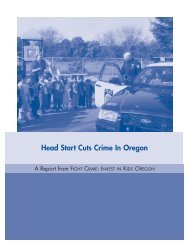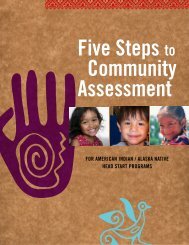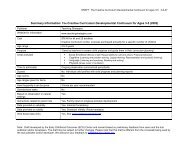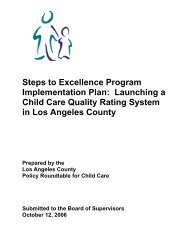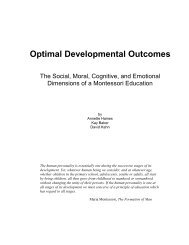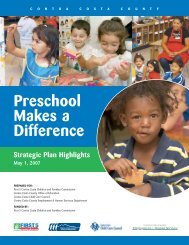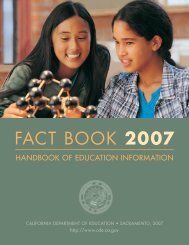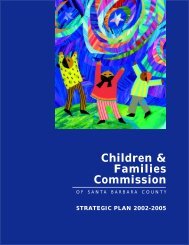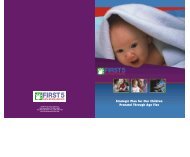Mapping the P-3 Continuum - Foundation for Child Development
Mapping the P-3 Continuum - Foundation for Child Development
Mapping the P-3 Continuum - Foundation for Child Development
You also want an ePaper? Increase the reach of your titles
YUMPU automatically turns print PDFs into web optimized ePapers that Google loves.
Educational expectations in <strong>the</strong> United States today, as reflected by high stakes testing, do notreflect <strong>the</strong> realities of children’s classroom and learning experiences. First, <strong>the</strong>re is variability inoutcomes between children who do or do not attend pre-kindergarten and/or kindergarten.Second, systematic classroom observations reveal marked variability in classroom quality andteaching, not only between schools, but also within schools from pre-k through third grade. 1This variability has been shown to lead to different classroom experiences and outcomes <strong>for</strong>students from P-3.By providing all children with access to a pre-kindergarten education, and requiring all childrento attend kindergarten, <strong>the</strong> academic playing field <strong>for</strong> all children can be fur<strong>the</strong>r leveled.Reducing variability in classroom learning environments by providing high-quality teacherpreparation is expected to contribute to better outcomes <strong>for</strong> children. Providing opportunities <strong>for</strong>parent involvement and offering access to support services can also assist our many low-incomechildren in <strong>the</strong> educational system.CRAFT A WORKING DEFINITION OF P-3What does P-3 mean?Special attention should be paid to <strong>the</strong> language, rhetoric, and framing of <strong>the</strong> P-3 idea to clearlycommunicate <strong>the</strong> goals of a P-3 initiative.P-3 represents <strong>the</strong> potential <strong>for</strong> a well-integrated education experience <strong>for</strong> children 3-8 years old.‘P’ refers to full-day, full-year, voluntary learning experiences <strong>for</strong> all children 3-4 years old.Pre-kindergarten helps children develop <strong>the</strong> skills necessary to be successful when <strong>the</strong>y enterkindergarten. ‘P’ is aligned with kindergarten and <strong>the</strong> early school years through third grade,providing a coherent, related set of experiences <strong>for</strong> children in <strong>the</strong> first several years of publicschooling. This integrated experience would embody different developmentally appropriatepractices, based on scientific research, <strong>for</strong> children at different ages and at different grade levels.<strong>Child</strong>ren’s experiences each year are based on <strong>the</strong> attainment of skills in <strong>the</strong> previous years.It is necessary to be intentional in <strong>the</strong> curriculum with a common goal – to provide all childrenwith an equal opportunity to succeed in school. This necessitates change in <strong>the</strong> infrastructure ofour educational system, including preparation and relevant credentialing <strong>for</strong> all teachers andschool leadership and climate <strong>for</strong> sustained professional development.Assumptions underlying P-31) Focusing on each year (pre-kindergarten, kindergarten, grades 1-3) as an isolated experienceis not sufficient to reduce <strong>the</strong> likelihood of academic underachievement. Typically, preventionand/or intervention services target child care settings, pre-kindergarten, kindergarten, or <strong>the</strong> earlyelementary grades. Research shows that <strong>the</strong>re is no ‘magic bullet’, targeted at one stage of1 Pianta, R. (2003). Standardized classroom observations from pre-k to 3 rd grade: A mechanism <strong>for</strong> improvingaccess to consistently high quality classroom experiences and practices during <strong>the</strong> P-3 years. A <strong>Foundation</strong> <strong>for</strong><strong>Child</strong> <strong>Development</strong> working paper.4



